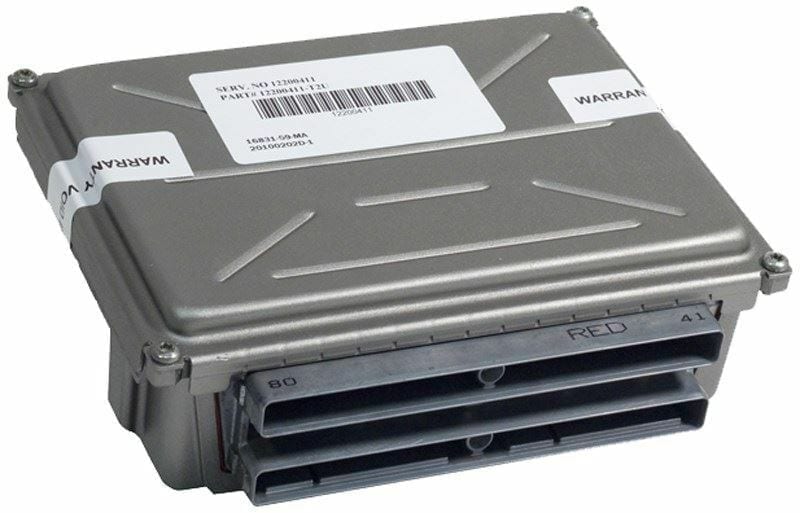Restore Peak Performance to Your GM Truck or SUV
Is your 2001-2002 Chevrolet Tahoe, Silverado, or other compatible GM vehicle running rough, stalling, or showing a persistent Check Engine Light? These are classic signs of a failing Powertrain Control Module (PCM), the central computer responsible for managing your engine’s performance, fuel economy, and emissions. A faulty PCM can cause a cascade of frustrating issues, from poor acceleration and harsh shifting to a complete no-start condition. This replacement PCM, service number 12200411, is the definitive solution to get your vehicle back on the road and running like new.
The Brain of Your Engine: Why the PCM is Crucial
The PCM in your vehicle is a sophisticated computer that constantly analyzes data from sensors throughout your engine and transmission. It processes information like engine speed, throttle position, coolant temperature, and oxygen levels to make millions of calculations per second. Based on this data, it precisely controls fuel injection, ignition timing, and transmission shift points. When it begins to fail, the entire powertrain system is compromised, leading to the symptoms you’re likely experiencing. This isn’t just an inconvenience; it can affect your vehicle’s safety, reliability, and fuel efficiency.
From the Diagnostic Bay
We had a 2002 Silverado 1500 come in that had its owner completely stumped. The truck would randomly stall at stoplights and had a rough, hunting idle. The owner had already replaced the spark plugs, ignition coils, and even the fuel pump, with no improvement. A quick scan showed no communication with the PCM. After checking the power and ground circuits to the module, which were all good, we knew the internal processor had failed. We installed one of our VIN-programmed PCMs, performed the security relearn, and the truck fired right up and idled perfectly. It’s a great reminder that sometimes the most complex problems point back to a single, central component.
Common Symptoms of a Failing 2001-2002 Tahoe PCM
If you’re noticing any of the following issues, it’s highly probable that your PCM is the culprit. A failing module can manifest in various ways, but these are the most common indicators our technicians see.
- ✔ Check Engine Light: The light is on, and you may have codes related to module communication (U-codes) or multiple, unrelated sensor failures.
- ✔ Engine Stalling or Misfiring: The engine may stall for no reason, run rough, or experience random misfires.
- ✔ No-Start Condition: The engine cranks but will not start, often due to a lack of fuel injector pulse or spark.
- ✔ Poor Fuel Economy: A sudden and unexplained drop in MPG is a strong indicator of an inefficiently running engine controlled by a faulty PCM.
- ✔ Harsh or Erratic Shifting: The PCM also controls the transmission. You might experience delayed engagement, hard shifts, or getting stuck in a single gear.
- ✔ Failed Emissions Test: The vehicle cannot pass an emissions or smog test due to incorrect engine parameters.
The Plug-and-Play Solution: VIN-Programmed for Your Vehicle
This isn’t a generic, one-size-fits-all part. To ensure a seamless installation and perfect operation, we program this PCM specifically for your vehicle using the VIN you provide at checkout. This process flashes the module with the latest, most stable software updates directly from GM. This critical step ensures that the PCM communicates flawlessly with your vehicle’s other modules, including the anti-theft system (PassLock/VATS), transmission, and instrument cluster. Simply provide your VIN, and we handle the complex programming for you.
Wide-Ranging Compatibility
This module is a direct replacement for service number 12200411 and is also compatible with part numbers 12201281, 12576160, and 52369718. It fits an extensive range of GM trucks, vans, and performance cars from the 2000-2003 era, including the Chevrolet Silverado, GMC Sierra, Suburban, Yukon, Express, Savana, Camaro, Corvette, and many more. Please verify the part number and check the detailed fitment list to confirm compatibility with your specific model and engine.
Installation Process
While professional installation is always recommended, replacing the PCM is a straightforward process for a seasoned DIYer. The module is typically located in the engine bay, often under the battery tray on the driver’s side. After disconnecting the battery, you can unbolt the module, carefully disconnect the wiring harness connectors, and install the new unit in its place. After installation, you will likely need to perform a security relearn procedure, which can often be done without special tools and takes about 30 minutes. Instructions for this procedure are widely available online for your specific vehicle.
Frequently Asked Questions
Do I need to do any programming after I receive this PCM?
No. We pre-program the module to your vehicle’s VIN before shipping. In most cases, the only additional step is a simple security relearn procedure that pairs the new PCM with your vehicle’s anti-theft system. This typically does not require a scanner.
Where do I find my VIN?
Your 17-digit Vehicle Identification Number (VIN) can be found on your vehicle’s registration, insurance card, or on a metal plate on the driver’s side of the dashboard, visible through the windshield.
Is this a new or used part?
This is a high-quality, reconditioned OEM part that has been thoroughly tested and verified to meet or exceed original factory specifications. It is then loaded with fresh, vehicle-specific software.
Will this fix my transmission shifting problems?
In many cases, yes. The PCM controls both the engine and the transmission. If the transmission issues are electronic and caused by a faulty module, this replacement part will resolve them. It will not fix internal mechanical issues with the transmission.
What is the security relearn procedure?
It’s a simple process that involves cycling the ignition key to allow the new PCM to recognize your vehicle’s anti-theft system. For most GM vehicles of this era, it involves turning the key to ‘ON’ for 10 minutes, ‘OFF’ for 10 seconds, and repeating this cycle three times. Specific instructions can be easily found for your model.


